YOGA POSES THAT CAN RELIEVE CONSTIPATION NATURALLY
Introduction: In today’s fast-paced world, people have been prone to a sedentary lifestyle, processed food, irregular sleep, and so on. Under these circumstances, Constipation is sneaking to create a global health issue. It is not only an occasional inconvenience after a heavy meal but also has evolved into a chronic gastrointestinal ailment affecting a large number of people across different age groups, cultures, and continents. According to the World Gastroenterology Organization, about 16% of the world population is suffering from chronic constipation, and this figure jumps to over 30-40% especially in the age group of 60 or more. Women, due to their lifestyle patterns and fluctuation in hormones, are usually more prone to constipation in comparison to men.
According to Ayurveda, this constipation is also termed as Vibandha or Vipratibandha, Krura Koshtha, Apanavata Vaigunya, Purisavaha Srotodusti, which means constipation, obstruction, encircling a circular bandage, and Kostha-Baddhata. It is not only the inability to pass stool smoothly, but also it reflects the imbalance of our body’s internal system, particularly the VATA DOSHA. It is more than just a symptom. It can significantly impact an individual’s quality of life, and if it is left unmanaged, it can lead to various health complications, such as bloating, abdominal discomfort, fatigue, irritability, and even it can create skin issues, all of which point to a clogged digestive fire or AGNI.
The reason is the accumulation of filthy matter within the intestine, and the result is the decomposition and contamination of blood with poisonous gas, which is our vital fluid. To get temporary relief from constipation, we often use Laxatives, but we fail to address the root cause of this chronic ailment, which leads to a long-term dependency on Laxatives. But we often forget to embrace our age-old method to get permanent relief from constipation. And that is “Practicing Yoga” to get a permanent solution to this chronic problem. Yoga is not a quick fix, but as a natural, time-tested, and holistic approach to restoring digestive rhythm and overall harmony.

In this article, we will delve into the connection between Yoga and Digestive health, explore various Asanas (Yoga Postures), Pranayama (Breathing technique), and Ayurvedic principles from which we can get permanent relief from constipation naturally to maintain a balanced, healthy, and comfortable life.
01. Understanding Constipation – Causes beyond Diet:
i. Poor Digestion and Slow Metabolism – A Root Cause of Constipation
The root cause of frequent constipation is poor digestion and sluggish metabolism. When the food is not broken down properly due to a weak digestive system, the undigested filthy matter accumulates within the intestine and causes decomposition and contamination of the blood, which is our vital fluid within the body. This not only disrupts the nutrient absorption but also slows down the natural bowel movement.
Slower metabolism is mainly responsible for converting food into energy. This causes the delay in transit time of stool through the colon, which causes the stool to become dry and hard which making the elimination difficult and painful.
Factors that contribute to poor digestion and slow metabolism are:
- Eating heavy, processed, or cold foods
- Skipping meals or eating foods irregularly
- Lack of physical activity
- High stress or mental overwork
- Inadequate water intake
In such a situation, Yoga helps to counter these issues by stimulating the abdominal organs, improving blood circulation, and calming the nervous system, all of which support a better digestive system and a more active metabolism to alleviate constipation.
ii. Sedentary Lifestyle and Irregular Routine:
Most of the people in this digital world spend a maximum time of the day sitting at a desk, in a car, or in front of a screen. The normal function of the organs cannot be expected by these people. The idle people who never like Yoga or physical exercise, normal abdominal function can also not be expected, and as a whole, they become the prey of Constipation.
This sedentary lifestyle not only weakens the muscle tone but also slows down the natural movement of the bowel, which is known as peristalsis. When there is no movement of the body, the digestive system becomes sluggish, which causes constipation.
But Yoga encourages a well-structured and mindful lifestyle. Regular practice of Yoga not only activates the proper digestive organs through movement but also promotes discipline, helping individuals to reconnect with the body’s natural rhythms for better intestinal health.
iii. Stress and Anxiety Related Bowel Issues:
a.How Stress and Anxiety Affect Gut Health: Before understanding this issue, we should be aware of the gut. The gut is a long muscular tube passing from the mouth to the anus, supported by several accessory organs and responsible for processing food, absorbing nutrients, and eliminating the body’s wastes.
The Brain and Gut are closely linked through the Brain-Gut Axis, which is a two-way communication system responsible for neural, hormonal, and immunological signaling. When a person is stressed or anxious, the Brain passes a signal to the Gut that can either slow down or speed up the digestion. Anxiety may aggravate Gut sensitivity, making mild sensations feel uncomfortable or even painful.
b.Common Bowel Issues linked to Stress and Anxiety:
- Irritable Bowel Symptoms
- Constipation
- Diarrhea
- Abdominal cramps and pain
- Loss of appetite/Nausea
c. Natural Remedies: In these cases, the following points are to be remembered:
- Yoga and Pranayama: Yoga and Pranayama calm the nervous system, reduce the cortisol level, and help with Gut movement.
- Meditation: Meditation can help to break the stress-response cycle by increasing awareness and emotional regulation.
- Diet Adjustment: Eating fiber-rich foods, avoiding caffeine, alcohol, smoking, and processed foods during flare-ups. Drinking enough water is helpful for digestion.
- Regular Exercise: Regular exercise, like Cycling, Walking, and Swimming, can stimulate digestion and reduce tension.
- Counseling or Therapy: Cognitive Behavioral Therapy (CBD) is highly helpful for managing stress-related digestive disorders.
- Nourishing Guts: For maintaining a healthy Gut, lifestyle and a healthy diet support its structure and microbial balance. A diverse diet rich in plant-based food is highly beneficial for the gut microbiota are highly beneficial.
iv. Over Dependence on Laxatives or Processed Food: A Hidden Culprit
Moreover, the use of laxatives can give a quick relief from constipation, but their frequent use can make the colon lazy. If it is overused, the intestine may become more dependent on external stimulation, which reduces its natural ability to contract and move stool smoothly. This can create chronic constipation and require more powerful laxatives.
Processed foods like Chips, Instant Noodles, White Bread, and ready-to-eat Meals usually lack fiber and are not helpful for healthy digestion. Fiber-rich foods help to bulk up stool and promote smooth stool movement. Fiber-deficient foods lead to hard and dry stool and slower bowel movement, which creates constipation.
v. Impact on Overall Wellbeing and Mental Health due to Constipation:
Constipation is not only a physical issue but also affects emotional and mental well-being. When the stool does not pass regularly, it creates toxins that lead to discomfort, bloating, and fatigue. This continuous uneasiness can drain energy levels, reduce motivation, and disturb daily life. In the long run, it leads to chronic irritability, anxiety, and low self-esteem. Yoga, mindfulness, and dietary improvement not only restore digestive balance but also boost mental clarity, emotional calm, and vitality.
2. Why Yoga Works: The Gut-Brain movement connection:
It is to be mentioned here that stress and anxiety instantly affect the stomach. This is not just an imagination but a scientifically proven link between the gut-brain connection. The gut and brain are closely connected with each other through a network of nerves, hormones, and other chemicals within the body, which is usually referred to as the enteric nervous system. When the mind is tensed, the gut feels it too.
Constipation is the end result of this connection. The signal between the brain and the gut is disrupted by chronic stress, lack of physical exercise, and emotional strain, and the end result is a slowing down of digestion and bowel movement. The traffic system within the body is jammed.
In this case also, yoga bridges the gap by combining Yoga Asanas, Breathing exercises, and mindfulness. This calms the nervous system within the body and helps a healthy Gut function. Yoga Asana massages the abdominal organs while Pranayama and Dhyana (Deep breathing and Meditation) reduce the cortisol level. When the body moves and the mind relaxes, the gut receives the message “It is the perfect time to proceed”. This is the strength of the Gut-Brain movement connection, which is a holistic pathway to restore the digestive process and overcome constipation, not just physically but also emotionally.
3. Top 7 Yoga Poses to get rid of Constipation:
I. Pawanmuktasana (Wind relieving Pose): Pawanmuktasana (Wind relieving Pose) is a highly effective yoga posture for relieving the accumulated gas, bloating, and constipation. This simple Yoga pose directly targets the affected areas (Abdominal area), stimulates the intestine, and helps with smooth bowel movement.
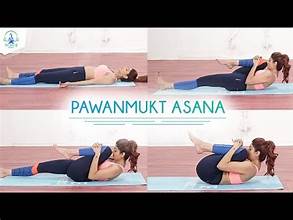
Here, we will discuss two types of Pawanmuktasana:
- Supta Pawanmuktasana (Leg Lock Pose):
How to Perform: Lie on the mat straight, bend the right knee, and bring the thigh to the chest by interlocking the fingers and holding tightly the hands on the shin just below the right knee, and keep the left leg straight on the mat. Inhale deeply, filling the lungs fully. Hold your breath for a few seconds and try to raise your head and shoulder off the mat, and try to touch your nose with your knee. Be in this position for a few seconds, and slowly. Now, slowly exhale and return to the earlier position. Relax the body. Try to repeat this pose with the left leg.
Now, bend both knees and bring them to the chest by clasping the hands on the shin. Inhale deeply. Hold your breath for a few seconds and raise your head and shoulders, and try to touch your nose with both knees. Be in this position for a few seconds and slowly release the breath, and return to the normal position.
Benefits: Supta Pawanmuktasana loosens the lower back portion of the body and the spinal vertebrae. It also massages the abdomen and the digestive organs, and, therefore, it is considered very helpful in removing the accumulated gas within the body and helps to get rid of constipation.
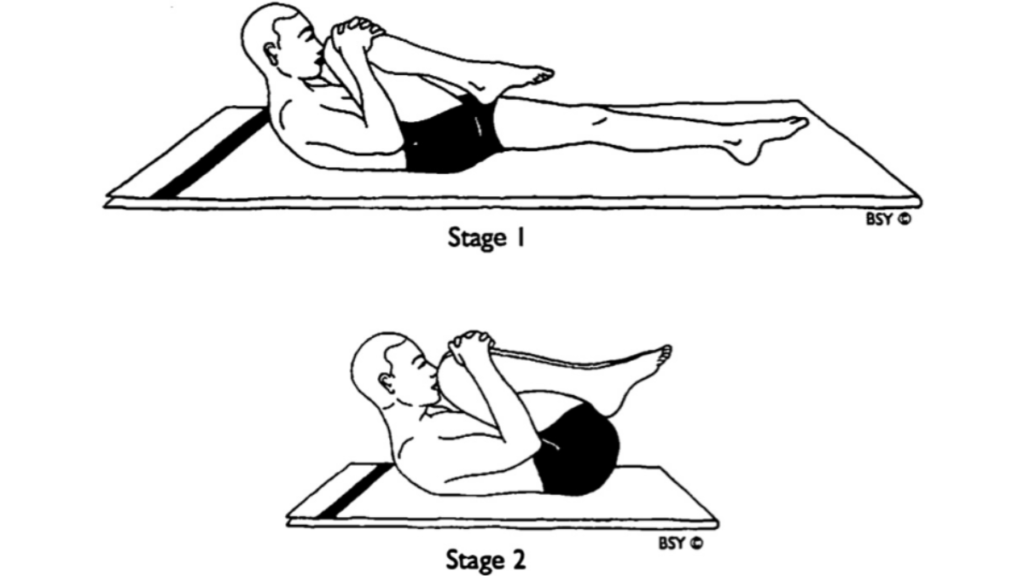
- Jhulana Lurhakanasana(Rocking and Rolling):
How to perform: Lie flat, straight on the mat. Inhale fully and bend both legs to the chest. Interlock the fingers of both hands and clasp them around the shins. Now, roll the body on both sides for 5-10 times, touching the floor.
Benefits: This yoga posture massages the back, buttocks, and hip. This also helps to remove the accumulated gas in the intestine and to get rid of constipation.
Both the above two poses are beginner-friendly friendly provide quick and noticeable results. If it is practiced regularly, it can help to reset the digestive system and provide relief from the discomfort of constipation naturally.

II. Ardha Matsyendrasana (Half Spinal Twist):
This Yoga Asana is highly beneficial in the case of acute constipation.
How to Perform: Sit on the mat in base position. Now, stretch legs straight on the floor in front of the body. Bend the right knee and right foot flat on the floor, with the outside of the left knee. The toes of the right foot should be faced forward. Now, bend the left leg and bring the foot around the right buttock. The outside edge of the foot should be in contact with the floor. The beginners may keep the left straight if bending is painful. Inhale and lengthen spine and sit tall. Exhale and try to twist your body to the right. Place your right hand behind your back. Now, bring the left elbow to the outside of the right knee. Try to use the elbow to deepen the twist gently. Keep the chest open and gaze at the right shoulder. Now, hold the pose for 20-30 seconds. Breath slowly and deeply. Now, release the pose slowly and exhale.
Now, repeat the pose at the opposite side. This should be done at least 4-5 rounds daily.
Benefit: This Asana stretches the muscle on one side of the back of the abdomen while contracting the muscles on the other side. Ardha Matsyendrasana massages the abdominal organs of the body, alleviating digestive problems. It regulates the secretion of adrenaline and bile for proper digestion and smooth bowel movement, thereby alleviating constipation.
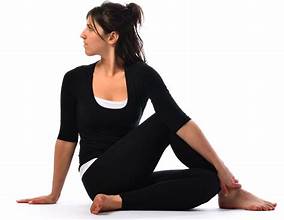
III. Vayu Nishkasana (Wind releasing pose):
Vayu Nishkasana is also known Wind releasing pose. It helps to release the trapped gas and relieve digestive discomfort. The name is derived from two Sanskrit words: Vayu means wind or air, and Nishkasana means to release.
How to Perform: Sit in the squatting position, keeping the feet 50-60 cms. Apart. Hold the insteps of the feet and place the fingers under the soles with the thumbs above. The upper arms are pressed against the inside of the knees with the elbows slightly bent while performing Wind Releasing Pose. Throughout the practice, the eyes should be kept open or can be gazed at the KUTASTHA (the center of the eyebrows). While moving back, inhale fully while practicing. While practicing, direct the gaze upward and inward. This is the starting position. Hold the breath for 5-10 seconds in this pose while bending the head backward as much as you can while practicing this pose. While exhaling, the knees should be kept straight, and now try to raise the buttocks and bring the head forward towards the knees. Now, hold your breath for 5-10 seconds. Don’t try hard if you feel strained.
Inhale further and return to the earlier position. This is one round of practice. Try this for 4-5 rounds.
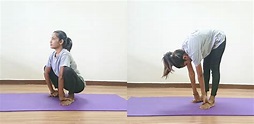
Benefits: This pose helps to strengthen the abdominal muscles and massages the intestine and other organs of the digestive tract and thereby improving the digestive system. It also helps to get rid of constipation while practicing regularly.
IV. Bhujangasana (Cobra Pose): This pose helps to stimulate the digestive organs and the secretion of digestive fluid. Therefore, if practiced regularly, it regulates the digestive system.
How to Perform: Keep the lower buttocks and hips on the floor. Straighten the elbows, arch the back, and push the chest forward into the cobra pose. Bend the head back and direct the gaze upward to the eyebrow center. The thighs and hips remain on the floor, and the arms support the trunk. Unless the spine is very flexible, the arms will remain slightly bent. Inhale while raising the body and arching the back.
Benefit: This pose stimulates the digestive system and relieves constipation.
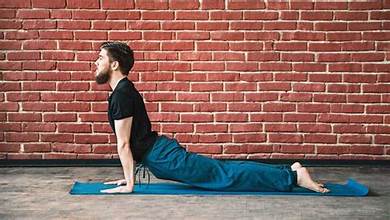
V. Shashankasana : (Rabbit Pose) – The word Shashankasana is derived from two Sanskrit words – Shashanka and Asana. Shashanka means Moon, and Asana means Yoga posture. Therefore, another name is Moon Pose. It’s another name is Rabbit Pose. While practicing, the body resembles the round spine of the Rabbit. Therefore, another name is Rabbit Pose.
How to Perform: Sit comfortably on the Yoga Mat in Vajrasana and place the arms on the thigh just above the knee. Keep the spine and head straight, close the eyes, and relax. Now, inhale fully and raise the arms above the head in line with the shoulders. Stay in this position for a few seconds. Then exhale, move the torso forward, and place the hands and head straight on the ground in front. If possible, the arms and forehead should touch the floor at the same time. Bend the arms slightly so that they are relaxed and let the elbows rest on the floor. Stay in this position for a few seconds. After this, slowly move in the earlier position while breathing in. It should be kept in mind that when you move breathe up, and when you move down, breathe out.
Benefit: Regular practice of the Rabbit Pose, the digestive muscles get a good stretch, and therefore the digestive process improves. The Rabbit Pose also regulates the metabolic process and helps in curing Constipation.

VI. Triyaka Tadasana (Swaying Palm Tree Pose):
How to Perform: Stand on the Yoga Mat keeping the feet apart (at least 2 feet). Fix the gaze at a point directly in front. Interlock the fingers and turn the palms outward. Inhale and raise the arms over the head. While exhaling, bend to the left side from the waist. Don’t bend forward or backward or twist the trunk. Hold the position for a few seconds while retaining the breath outside. Inhale and slowly come to the upright position. Now, repeat the pose on the right side. From the upright position, exhale while bringing the arms down to the sides. This is one round of practice. Practice it for 5-10 rounds daily.
Benefits: It is highly helpful in relieving constipation. It stimulates the digestive organs, especially the intestines and liver. Improves the flexibility in the abdominal and spinal muscles. Helps to release trapped gas and reduce bloating. This pose also helps to enhance the blood circulation in the abdominal region and promote downward energy needed for smooth bowel movement and cure constipation.
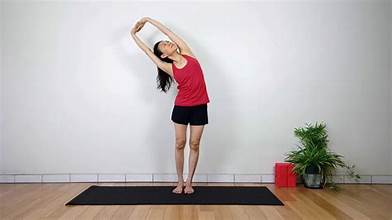
VII. Kati Chakrasana (Standing Spinal Twist): Katichakrasana which is also known as Standing Spinal Twist which is a dynamic and energizing pose that involves gentle twisting of the spine while standing. This movement has powerful effects on the digestive system, making it highly beneficial for those who are suffering from constipation.
How to perform: Stand with your feet shoulder-width apart and arms at your sides. Inhale and raise both arms to shoulder height, parallel to the ground. Exhale and twist your upper body to the right, bringing your left hand to your right shoulder and your right hand behind your back. Gently look over your right shoulder, keeping your spine tall. Inhale and return to the center. Exhale and repeat the twist to the left side, following the same steps. Perform 10–15 gentle twists on each side.
Benefits: When Katichakrasana is practiced daily, this pose helps to relieve constipation naturally by boosting circulation, stimulating internal organs, and promoting healthy elimination—all without strain or medication. This helps in the following ways:
It activates and tones the digestive organs. Stimulates bowel movements through twisting compression. Relieves gas, bloating, and sluggish digestion. Promotes the downward movement of Apana Vayu (eliminative energy). Reduces stress and tension that may contribute to digestive issues.
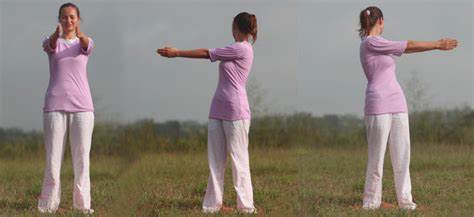
4. Life Style and Diet tips for supporting Yogic Healing of Constipation:
- Eat fiber-rich food (fruits, vegetables, and whole grains)
- Drink lukewarm water in the morning
- Maintain a consistent sleep schedule
- Avoid processed food, caffeine, and irregular meals
- Combine Yoga in the morning and a light activity
5. A real-life story: From acute constipation to Comfort through Yoga:
During my early life (within the age range of 30-35 years), I was posted in a large power plant situated in a remote part of India. During the construction phase, there was no fixed time for my office hours. Therefore, I had to stay up to late at night to check the activities. My lifestyle changed. There was no fixed time for lunch and dinner. I could not understand, the constipation had silently attacked me. When it became acute, I could not find any way out.
Despite using multiple laxatives, fiber supplements, and even dietary changes, my mornings began with bloating, discomfort, and frustration. I could not pay full attention to my job. Irregular bowel habits affected my energy level, focus, and even my mood.
One day, I discussed my problem with one of my close friends, and upon hearing, he advised me to start Yoga for improving my digestive system. I was skeptical but desperate and determined to start Yoga. I contacted a Yoga Teacher. On hearing my problem, he advised me to attend his classes. As per his instruction, I started Pawanmuktasana, Kapalbhati Pranayama, Bhujangasana, and obviously Vajrasana. Started taking lukewarm water in the morning and at night started taking Bread, Milk, and Banana. I continued this for nearly two months.
After continuous practice for two months, I felt my belly lighter, the bloating reduced, and I started passing stool smoothly and regularly. By the end of the two-month period, I started waking up naturally with an urge to and felt “clean” throughout the day, which I had not experienced in years.
After a lapse of six months, Yoga has become a non-negotiable part of my morning. I used no more laxatives, felt no more frustration – just a deeper connection with my body. Yoga did not just fix my constipation; it gave me back my happy mornings, my confidence, and peace in mind.
6. Conclusion: Take steps towards a Lighter and Healthier Life:
Constipation should not be regarded as an occasional discomfort – it affects mood, energy, and overall quality of life. Here, the “Good News” is that you don’t need to be dependent on Laxatives or quick fixes. You can stimulate your digestive system, restore natural bowel movement, and feel happy every day without feeling any pain in the morning through simple, consistent Yoga practice.
From Pawanmuktasana to Tiryaka Tadasana, these powerful Yoga Poses work with your body that help your digestive system eliminate wastes naturally. Combine these Poses with Pranayama, proper hydration, and a fiber-rich diet, and will be amazed how quickly your Gut Health transforms.
Therefore, roll out your Yoga Mat, commit to 15-20 minutes daily, and let your body discover its natural rhythm.
THANKS TO YOGA FOR GIVING ME RELIEF FROM CONSTIPATION.
FAQ:
Question 1: What are the home remedies for constipation?
Ans: Constipation can be managed at home without using any laxatives. Only you have to change certain daily habits, diet, proper hydration that support the body’s natural and smooth passing of stool. Here are some home remedies that will help you to find relief:
- Drink lukewarm water in the morning on an empty belly
- Increase vegetables in your meal and fiber-rich food
- Stay properly hydrated throughout the day
- Try to add soaked Raisins or Prunes
- Add Triphala Powder (Mix 1 teaspoon with warm water before bed)
- Perform physical exercise or Yoga daily
- Avoid using processed food
- Manage stress
Question 2: Can Yoga replace Laxatives completely?
Ans: The answer is YES for most of the people, but with certain conditions:
Yoga works differently from using laxatives. Instead of forcing the bowel to pass out smoothly, yoga stimulates the digestive organs naturally, improves blood circulation, strengthens abdominal muscles, and balances the nervous system. Over time, these effects restore the body’s natural ability to remove wastes without using laxatives.
Poses like Pawanmuktasana, Vajrasana, Malasana, and Ardha Matsyendrasana are highly beneficial. Pranayama like Kapalbhati and Bhastrika Pranayama directly target the root cause of constipation, like slow digestion, weak peristalsis, and stress.
Question 3: Can beginners perform these poses?
Ans: In short, the answer is “YES”. Most of the Yoga Poses for constipation relief, such as Pawanmuktasana, Tadasana, Malasana, Tiryaka Tadasana, and Katichakrasana, are all beginner-friendly. These poses do not require prior Yoga experience, no equipment, and can be performed at home.
Question 4: How often should I practice Yoga to relieve constipation?
Ans: To get the best results for relieving constipation, consistency is essential rather than intensity. Yoga works gradually by improving digestion, stimulating intestinal movement, and cooling down the nervous system. To get noticeable improvement, the following are essential aspects:
- Daily practice
- Minimum frequency
- Short routine works
- Integration of Lifestyle
Question 5: What time of the day is best for performing these Yoga Poses?
Ans: The time is important for practicing Yoga. Since Yoga aims to stimulate digestion, active peristalsis, and bowel movement, the goal is to practice when the body is highly receptive. Therefore, before Sunrise is the best time, i.e., between 4.30 AM to 6.30 AM. Alternatively, you can also practice in the evening.
Question 6: Should I avoid Yoga Practice if I have hemorrhoids?
Ans: If you have mild to moderate hemorrhoids, Yoga Practice can be continued with caution. If you feel it is painful, avoid this. But you should keep in mind that Yoga Practice improves Blood circulation, reduces pelvic pressure, and supports smooth bowel movement that prevents constipation, which is a major trigger of hemorrhoids.
Question 7: Which Yoga Pose is best for relieving Constipation?
Ans: Poses like Wind Relieving and Seated Spinal Twist are highly effective for relieving constipation. These poses gently massage the abdominal muscles to encourage proper digestion and stimulate bowel movement that eases discomfort and promotes regularity.






